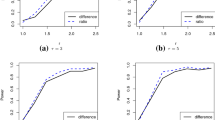Abstract
In follow-up studies, survival data often include subjects who have had a certain event at recruitment and may potentially experience a series of subsequent events during the follow-up period. This kind of survival data collected under a cross-sectional sampling criterion is called truncated serial event data. The outcome variables of interest in this paper are serial sojourn times between successive events. To analyze the sojourn times in truncated serial event data, we need to confront two potential sampling biases arising simultaneously from a sampling criterion and induced informative censoring. In this study, nonparametric estimation of the joint probability function of serial sojourn times is developed by using inverse probabilities of the truncation and censoring times as weight functions to accommodate these two sampling biases under various situations of truncation and censoring. Relevant statistical properties of the proposed estimators are also discussed. Simulation studies and two real data are presented to illustrate the proposed methods.



Similar content being viewed by others
References
Fleming TR, Harrington DP (1991) Counting processes and survival analysis. Wiley, New York
Chang S-H, Tzeng S-J (2005) Nonparametric estimation for serial sojourn times under random truncation, Techincal Report, Division of Biostat., Institute of Epi., College of Public Health, National Taiwan University
Chen THH, Chiu YC, Luh DL, Yen MF, Wu HM, Chen LS, Taiwan Community-based Integrated Screening Group (2004) Community-based multiple screening model: design, implementation, and analysis of 42,387 participants. Cancer 100:1734–1743
Clayton DG (1987) A model for association in bivariate life tables and its application in epidemiological studies of familial tendency in chronic disease incidence. Biometrika 65:141–151
Gurler U (1996) Bivariate estimation with right-truncated data. J Amer Stat Assoc 91:1152–1165
Gurler U (1997) Bivariate distribution and hazard function when a component is randomly truncated. J. Multivariate Anal. 60:20–47
Huang J, Vieland VJ, Wang K (2001) Nonparametric estimation of marginal distributions under bivariate truncation with application to testing for age-of-onset anticipation. Stat Sinica 11:1047–1068
Kalbfleisch JD, Lawless JF (1999) Regression models for right truncated data with applications to AIDS incubation times and reporting lags. Stat Sinica 1:19–32
Lin DY, Sun W, Ying Z (1999) Nonparametric estimation of the gap time distributions for serial events with censored data. Biometrika 86:59–70
Lin DY, Ying Z (1994) Semiparametric analysis of the additive risk model. Biometrika 81:61–71
Lin MR, Chang S-H, Pai L, Keyl PM (2003) A longitudinal study of risk factors for motorcycle crashes among junior colleges in Taiwan. Accid Anal Prev 35:243–252
Pruitt RC (1991) On negative mass assigned by the bivariate Kaplan–Meier estimation. Ann Statist 19:443–453
Tsai W-Y, Jewell NP, Wang M-C (1987) A note on the product-limit estimator under right censoring and left truncation. Biometrika 74:883–886
Quale CM, van der Laan MJ (2000) Inference with bivariate truncated data. Lifetime Data Anal 6:391–408
van der Laan MJ (1996) Nonparametric estimation of the bivariate survival function with truncated data. J Multivariate Anal 58:107–131
Visser M (1996) Nonparametric estimation of the bivariate survival function with an application to vertically transmitted AIDS. Biometrika 83:507–518
Wang M-C (1991) Nonparametric estimation from cross-sectional survival data. J Amer Stat Assoc 86:130–142
Wang M-C (1999) Gap time bias in incident and prevalent cohorts. Stat Sinica 9:999–1010
Wang W-J, Wells MT (1998) Nonparametric estimation of successive duration times under dependent censoring. Biometrika 85:561–572
Acknowledgments
We are very grateful to Associate Editor and two referees for their constructive comments that led to a significant improvement of this paper. We thank Dr. Mau-Roung Lin at Taipei Medical University Institute of Injury Prevention and Control for providing the anonymous motorcycle crash data. We also thank the Department of Health, Taiwan, R.O.C. for providing the Taiwan Cancer registry and Death registry data. Part of this work was supported by NSC-91-2118-M-002-003 from National Science Council in Taiwan.
Author information
Authors and Affiliations
Corresponding author
Rights and permissions
About this article
Cite this article
Chang, SH., Tzeng, SJ. Nonparametric Estimation of Sojourn Time Distributions for Truncated Serial Event Data—a Weight-adjusted Approach. Lifetime Data Anal 12, 53–67 (2006). https://doi.org/10.1007/s10985-005-7220-9
Received:
Accepted:
Issue Date:
DOI: https://doi.org/10.1007/s10985-005-7220-9




